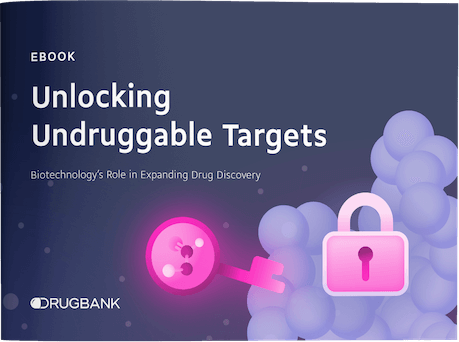Explore a selection of our essential drug information below, or:
Overview
- DrugBank ID
- DB02921
- Type
- Small Molecule
- Clinical Trials
- Phase 0
- 0
- Phase 1
- 0
- Phase 2
- 0
- Phase 3
- 0
- Phase 4
- 0
- Mechanism of Action
- Thymidine kinase, cytosolicInhibitor
- Thymidine kinase, cytosolic
Identification
- Generic Name
- (South)-Methanocarba-Thymidine
- DrugBank Accession Number
- DB02921
- Background
Not Available
- Type
- Small Molecule
- Groups
- Experimental
- Structure
- Weight
- Average: 252.2664
Monoisotopic: 252.11100701 - Chemical Formula
- C12H16N2O4
- Synonyms
- (South)-methanocarbathymidine
Pharmacology
- Indication
Not Available
 Reduce drug development failure ratesBuild, train, & validate machine-learning modelswith evidence-based and structured datasets.Build, train, & validate predictive machine-learning models with structured datasets.
Reduce drug development failure ratesBuild, train, & validate machine-learning modelswith evidence-based and structured datasets.Build, train, & validate predictive machine-learning models with structured datasets.- Contraindications & Blackbox Warnings
 Prevent Adverse Drug Events TodayTap into our Clinical API for life-saving information on contraindications & blackbox warnings, population restrictions, harmful risks, & more.Avoid life-threatening adverse drug events with our Clinical API
Prevent Adverse Drug Events TodayTap into our Clinical API for life-saving information on contraindications & blackbox warnings, population restrictions, harmful risks, & more.Avoid life-threatening adverse drug events with our Clinical API- Pharmacodynamics
Not Available
- Mechanism of action
Target Actions Organism AThymidine kinase, cytosolic inhibitorHumans UThymidine kinase inhibitorHHV-1 - Absorption
Not Available
- Volume of distribution
Not Available
- Protein binding
Not Available
- Metabolism
- Not Available
- Route of elimination
Not Available
- Half-life
Not Available
- Clearance
Not Available
- Adverse Effects
 Improve decision support & research outcomesWith structured adverse effects data, including: blackbox warnings, adverse reactions, warning & precautions, & incidence rates. View sample adverse effects data in our new Data Library!Improve decision support & research outcomes with our structured adverse effects data.
Improve decision support & research outcomesWith structured adverse effects data, including: blackbox warnings, adverse reactions, warning & precautions, & incidence rates. View sample adverse effects data in our new Data Library!Improve decision support & research outcomes with our structured adverse effects data.- Toxicity
Not Available
- Pathways
- Not Available
- Pharmacogenomic Effects/ADRs
- Not Available
Interactions
- Drug Interactions
- This information should not be interpreted without the help of a healthcare provider. If you believe you are experiencing an interaction, contact a healthcare provider immediately. The absence of an interaction does not necessarily mean no interactions exist.Not Available
- Food Interactions
- Not Available
Categories
- Drug Categories
- Not Available
- Chemical TaxonomyProvided by Classyfire
- Description
- This compound belongs to the class of organic compounds known as cyclopentyl nucleosides. These are nucleoside analogues with a structure that consists of a cyclobutane that is substituted a the 1-position with a hydroxyl group and at the 2- or the 3- position with either a purine or pyrimidine base.
- Kingdom
- Organic compounds
- Super Class
- Nucleosides, nucleotides, and analogues
- Class
- Nucleoside and nucleotide analogues
- Sub Class
- Cyclopentyl nucleosides
- Direct Parent
- Cyclopentyl nucleosides
- Alternative Parents
- Pyrimidones / Hydropyrimidines / Vinylogous amides / Heteroaromatic compounds / Ureas / Secondary alcohols / Lactams / Cyclic alcohols and derivatives / Azacyclic compounds / Primary alcohols show 4 more
- Substituents
- Alcohol / Aromatic heteropolycyclic compound / Azacycle / Cyclic alcohol / Cyclopentyl nucleoside / Heteroaromatic compound / Hydrocarbon derivative / Hydropyrimidine / Lactam / Organic nitrogen compound show 12 more
- Molecular Framework
- Aromatic heteropolycyclic compounds
- External Descriptors
- secondary alcohol, pyrimidone, primary alcohol, carbobicyclic compound, C-glycosyl pyrimidine (CHEBI:45586)
- Affected organisms
- Not Available
Chemical Identifiers
- UNII
- Not Available
- CAS number
- Not Available
- InChI Key
- XRMLXZVSFIBRRJ-PEFMBERDSA-N
- InChI
- InChI=1S/C12H16N2O4/c1-6-4-14(11(18)13-10(6)17)12-2-8(12)7(5-15)9(16)3-12/h4,7-9,15-16H,2-3,5H2,1H3,(H,13,17,18)/t7-,8-,9-,12-/m0/s1
- IUPAC Name
- 1-[(1S,3S,4R,5S)-3-hydroxy-4-(hydroxymethyl)bicyclo[3.1.0]hexan-1-yl]-5-methyl-1,2,3,4-tetrahydropyrimidine-2,4-dione
- SMILES
- CC1=CN(C(=O)NC1=O)[C@]12C[C@H]1[C@H](CO)[C@@H](O)C2
References
- General References
- Not Available
- External Links
- PDB Entries
- 1of1
Clinical Trials
- Clinical Trials
Clinical Trial & Rare Diseases Add-on Data Package
Explore 4,000+ rare diseases, orphan drugs & condition pairs, clinical trial why stopped data, & more. Preview package Phase Status Purpose Conditions Count Start Date Why Stopped 100+ additional columns Unlock 175K+ rows when you subscribe.View sample data
Pharmacoeconomics
- Manufacturers
- Not Available
- Packagers
- Not Available
- Dosage Forms
- Not Available
- Prices
- Not Available
- Patents
- Not Available
Properties
- State
- Solid
- Experimental Properties
- Not Available
- Predicted Properties
Property Value Source Water Solubility 38.7 mg/mL ALOGPS logP -0.83 ALOGPS logP -1.6 Chemaxon logS -0.81 ALOGPS pKa (Strongest Acidic) 10.3 Chemaxon pKa (Strongest Basic) -2.6 Chemaxon Physiological Charge 0 Chemaxon Hydrogen Acceptor Count 4 Chemaxon Hydrogen Donor Count 3 Chemaxon Polar Surface Area 89.87 Å2 Chemaxon Rotatable Bond Count 2 Chemaxon Refractivity 62.19 m3·mol-1 Chemaxon Polarizability 25.29 Å3 Chemaxon Number of Rings 3 Chemaxon Bioavailability 1 Chemaxon Rule of Five Yes Chemaxon Ghose Filter No Chemaxon Veber's Rule No Chemaxon MDDR-like Rule No Chemaxon - Predicted ADMET Features
Property Value Probability Human Intestinal Absorption + 0.9615 Blood Brain Barrier - 0.6291 Caco-2 permeable - 0.7301 P-glycoprotein substrate Substrate 0.5431 P-glycoprotein inhibitor I Non-inhibitor 0.8165 P-glycoprotein inhibitor II Non-inhibitor 0.9559 Renal organic cation transporter Non-inhibitor 0.8762 CYP450 2C9 substrate Non-substrate 0.6097 CYP450 2D6 substrate Non-substrate 0.8368 CYP450 3A4 substrate Substrate 0.5464 CYP450 1A2 substrate Non-inhibitor 0.8872 CYP450 2C9 inhibitor Non-inhibitor 0.7536 CYP450 2D6 inhibitor Non-inhibitor 0.8846 CYP450 2C19 inhibitor Non-inhibitor 0.8414 CYP450 3A4 inhibitor Non-inhibitor 0.9405 CYP450 inhibitory promiscuity Low CYP Inhibitory Promiscuity 0.9107 Ames test Non AMES toxic 0.7139 Carcinogenicity Non-carcinogens 0.721 Biodegradation Not ready biodegradable 0.7848 Rat acute toxicity 2.2640 LD50, mol/kg Not applicable hERG inhibition (predictor I) Weak inhibitor 0.9721 hERG inhibition (predictor II) Non-inhibitor 0.7551
Spectra
- Mass Spec (NIST)
- Not Available
- Spectra
Spectrum Spectrum Type Splash Key Predicted GC-MS Spectrum - GC-MS Predicted GC-MS splash10-004i-3980000000-f45e8afde6c2ad6632ed Predicted MS/MS Spectrum - 10V, Positive (Annotated) Predicted LC-MS/MS splash10-0kdi-3970000000-37f833e161aa702ed9d1 Predicted MS/MS Spectrum - 10V, Negative (Annotated) Predicted LC-MS/MS splash10-0udi-0090000000-011c6886ae5d60e46af8 Predicted MS/MS Spectrum - 20V, Positive (Annotated) Predicted LC-MS/MS splash10-0560-8910000000-95d6bf52363a13bc8f70 Predicted MS/MS Spectrum - 20V, Negative (Annotated) Predicted LC-MS/MS splash10-001i-2940000000-550f0f4b5255fb3e93fd Predicted MS/MS Spectrum - 40V, Positive (Annotated) Predicted LC-MS/MS splash10-0a4i-2920000000-49e9c73edd109a81ca8d Predicted MS/MS Spectrum - 40V, Negative (Annotated) Predicted LC-MS/MS splash10-0f96-3950000000-8188cae8cf2c339ff81f Predicted 1H NMR Spectrum 1D NMR Not Applicable Predicted 13C NMR Spectrum 1D NMR Not Applicable - Chromatographic Properties
Collision Cross Sections (CCS)
Adduct CCS Value (Å2) Source type Source [M-H]- 155.41267 predictedDeepCCS 1.0 (2019) [M+H]+ 157.77066 predictedDeepCCS 1.0 (2019) [M+Na]+ 165.71884 predictedDeepCCS 1.0 (2019)
Targets

Build, predict & validate machine-learning models
Use our structured and evidence-based datasets to unlock newinsights and accelerate drug research.
Use our structured and evidence-based datasets to unlock new insights and accelerate drug research.
- Kind
- Protein
- Organism
- Humans
- Pharmacological action
- Yes
- Actions
- Inhibitor
- General Function
- Cell-cycle-regulated enzyme of importance in nucleotide metabolism (PubMed:9575153). Catalyzes the first enzymatic step in the salvage pathway converting thymidine into thymidine monophosphate (PubMed:22385435). Transcriptional regulation limits expression to the S phase of the cell cycle and transient expression coincides with the oscillation in the intracellular dTTP concentration (Probable). Also important for the activation of anticancer and antiviral nucleoside analog prodrugs such as 1-b-d-arabinofuranosylcytosine (AraC) and 3c-azido-3c-deoxythymidine (AZT) (PubMed:22385435)
- Specific Function
- ATP binding
- Gene Name
- TK1
- Uniprot ID
- P04183
- Uniprot Name
- Thymidine kinase, cytosolic
- Molecular Weight
- 25468.455 Da
References
- Zhou Y, Zhang Y, Zhao D, Yu X, Shen X, Zhou Y, Wang S, Qiu Y, Chen Y, Zhu F: TTD: Therapeutic Target Database describing target druggability information. Nucleic Acids Res. 2024 Jan 5;52(D1):D1465-D1477. doi: 10.1093/nar/gkad751. [Article]
- Kind
- Protein
- Organism
- HHV-1
- Pharmacological action
- Unknown
- Actions
- Inhibitor
- General Function
- Catalyzes the transfer of the gamma-phospho group of ATP to thymidine to generate dTMP in the salvage pathway of pyrimidine synthesis. The dTMP serves as a substrate for DNA polymerase during viral DNA replication. Allows the virus to be reactivated and to grow in non-proliferative cells lacking a high concentration of phosphorylated nucleic acid precursors.
- Specific Function
- ATP binding
- Gene Name
- TK
- Uniprot ID
- Q9QNF7
- Uniprot Name
- Thymidine kinase
- Molecular Weight
- 40896.475 Da
References
- Schelling P, Claus MT, Johner R, Marquez VE, Schulz GE, Scapozza L: Biochemical and structural characterization of (South)-methanocarbathymidine that specifically inhibits growth of herpes simplex virus type 1 thymidine kinase-transduced osteosarcoma cells. J Biol Chem. 2004 Jul 30;279(31):32832-8. doi: 10.1074/jbc.M313343200. Epub 2004 May 25. [Article]
Drug created at June 13, 2005 13:24 / Updated at August 26, 2024 19:22


